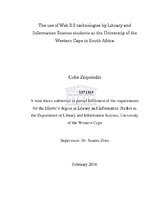The use of Web 2.0 technologies by Library and Information Science students at the University of the Western Cape in South Africa
Abstract
The purpose of this research was to investigate the use of Web 2.0 technologies by
Library and Information Science (LIS) students at the University of the Western Cape (UWC). This research provided answers to the following questions: • Which Web 2.0 technologies are used mostly by LIS students? • What do LIS students use Web 2.0 technologies for? • How is the LIS curriculum crafted to include training on Web 2.0 technologies? • What benefits (gratifications) do LIS students derive from the use of Web 2.0 technologies? • Which Web 2.0 technologies are LIS students being taught? Blumer and Katz’s (1974) Uses and Gratification Theory which explains the reasons behind people’s use of Web 2.0 technologies was used to provide meaning to the research findings. A mixed methods case approach was used in this study and as a result, a questionnaire, content analysis and interviews were used to collect data. Findings of this study revealed that, between 72% and 97% of the LIS students do have accounts on the following Web 2.0 technologies: YouTube, Skype, Google Apps, WhatsApp, Twitter and Facebook. It has been highlighted in this research that LIS students use Web 2.0 technologies for both academic and general purposes. Over 80% of the LIS students use Web 2.0 technologies for entertainment, keeping up-to-date, and meeting people as well as for communication with peers and lecturers. Analysis of the LIS Department’s curriculum documents, assignments as well as key informant interviews revealed that, while a module entitled "Web 2.0" does not exist, elements of Web 2.0 technologies are embedded in some of the LIS modules. The research results also showed that, between 89.4% and 96.5% of the LIS students either agreed or strongly agreed that Web 2.0 technologies plays a significant role in improving technology proficiency, extending learning beyond the classroom, providing a platform for entertainment, facilitating collaborative learning, improving
knowledge sharing and collaboration, providing cheaper and efficient communication platforms, providing easier and faster access to information; and that a low level of complexity is needed to use Web 2.0 technologies (ease of use). Ninety five per cent of the LIS students indicated that they support the inclusion of Web 2.0 technologies in the LIS curriculum a sentiment also shared by five of the interviewed key informants. Based on the research findings the researcher has recommended that the LIS curriculum should be regularly renewed to address new trends and technologies.

